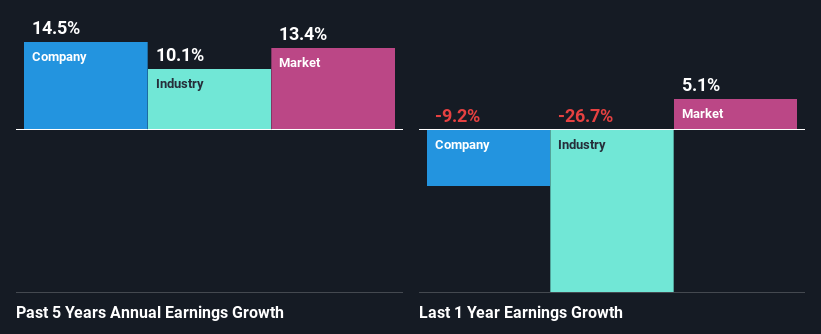Inari Amertron Berhad's (KLSE:INARI) Stock On An Uptrend: Could Fundamentals Be Driving The Momentum?
Inari Amertron Berhad's (KLSE:INARI) stock is up by a considerable 15% over the past three months. Given that stock prices are usually aligned with a company's financial performance in the long-term, we decided to study its financial indicators more closely to see if they had a hand to play in the recent price move. Specifically, we decided to study Inari Amertron Berhad's ROE in this article.
Return on equity or ROE is an important factor to be considered by a shareholder because it tells them how effectively their capital is being reinvested. Put another way, it reveals the company's success at turning shareholder investments into profits.
See our latest analysis for Inari Amertron Berhad
How Do You Calculate Return On Equity?
The formula for ROE is:
Return on Equity = Net Profit (from continuing operations) ÷ Shareholders' Equity
So, based on the above formula, the ROE for Inari Amertron Berhad is:
10.0% = RM314m ÷ RM3.2b (Based on the trailing twelve months to March 2024).
The 'return' refers to a company's earnings over the last year. So, this means that for every MYR1 of its shareholder's investments, the company generates a profit of MYR0.10.
What Is The Relationship Between ROE And Earnings Growth?
So far, we've learned that ROE is a measure of a company's profitability. We now need to evaluate how much profit the company reinvests or "retains" for future growth which then gives us an idea about the growth potential of the company. Generally speaking, other things being equal, firms with a high return on equity and profit retention, have a higher growth rate than firms that don’t share these attributes.
A Side By Side comparison of Inari Amertron Berhad's Earnings Growth And 10.0% ROE
On the face of it, Inari Amertron Berhad's ROE is not much to talk about. However, the fact that the company's ROE is higher than the average industry ROE of 6.1%, is definitely interesting. This probably goes some way in explaining Inari Amertron Berhad's moderate 14% growth over the past five years amongst other factors. Bear in mind, the company does have a moderately low ROE. It is just that the industry ROE is lower. Therefore, the growth in earnings could also be the result of other factors. For example, it is possible that the broader industry is going through a high growth phase, or that the company has a low payout ratio.
Next, on comparing with the industry net income growth, we found that Inari Amertron Berhad's growth is quite high when compared to the industry average growth of 10% in the same period, which is great to see.
The basis for attaching value to a company is, to a great extent, tied to its earnings growth. It’s important for an investor to know whether the market has priced in the company's expected earnings growth (or decline). By doing so, they will have an idea if the stock is headed into clear blue waters or if swampy waters await. Is Inari Amertron Berhad fairly valued compared to other companies? These 3 valuation measures might help you decide.
Is Inari Amertron Berhad Efficiently Re-investing Its Profits?
Inari Amertron Berhad has a significant three-year median payout ratio of 93%, meaning that it is left with only 6.7% to reinvest into its business. This implies that the company has been able to achieve decent earnings growth despite returning most of its profits to shareholders.
Additionally, Inari Amertron Berhad has paid dividends over a period of at least ten years which means that the company is pretty serious about sharing its profits with shareholders. Our latest analyst data shows that the future payout ratio of the company over the next three years is expected to be approximately 98%. Still, forecasts suggest that Inari Amertron Berhad's future ROE will rise to 22% even though the the company's payout ratio is not expected to change by much.
Conclusion
On the whole, we do feel that Inari Amertron Berhad has some positive attributes. Namely, its high earnings growth, which was probably achieved due to its respectable ROE. However, the considerably low reinvestment rate does diminish our excitement to a certain extent. On studying current analyst estimates, we found that analysts expect the company to continue its recent growth streak. Are these analysts expectations based on the broad expectations for the industry, or on the company's fundamentals? Click here to be taken to our analyst's forecasts page for the company.
Have feedback on this article? Concerned about the content? Get in touch with us directly. Alternatively, email editorial-team (at) simplywallst.com.
This article by Simply Wall St is general in nature. We provide commentary based on historical data and analyst forecasts only using an unbiased methodology and our articles are not intended to be financial advice. It does not constitute a recommendation to buy or sell any stock, and does not take account of your objectives, or your financial situation. We aim to bring you long-term focused analysis driven by fundamental data. Note that our analysis may not factor in the latest price-sensitive company announcements or qualitative material. Simply Wall St has no position in any stocks mentioned.
Have feedback on this article? Concerned about the content? Get in touch with us directly. Alternatively, email editorial-team@simplywallst.com

 Yahoo Finance
Yahoo Finance 
